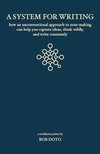A System for Writing: How an Unconventional Approach to Note-Making Can Help You Capture Ideas, Think Wildly, and Write Constantly - A Zettelkasten Primer
amazon.com
Saved by Vladimír Briš (ivb) and
A System for Writing: How an Unconventional Approach to Note-Making Can Help You Capture Ideas, Think Wildly, and Write Constantly - A Zettelkasten Primer

Saved by Vladimír Briš (ivb) and
The important thing is to bring the fact into contact with your own thinking. It’s what you have to say about the facts that matters most.
By giving your ideas a place to land, an inbox helps alleviate some of the potential anxiety that initially comes from working non-hierarchically (5.6). Later, when you process your inbox (that is, convert your fleeting notes into main notes), you can bring only what remains interesting into your network of ideas. I recommend processing the
... See moreThe structure of a Luhmann-style zettelkasten is not predetermined. It emerges out of the relationships the note maker establishes between ideas recorded in the notes. As relationships develop, areas of the zettelkasten swell. Common topics and themes emerge and are recorded in additional notes or otherwise indicated in the system.
If you’re someone who likes to work on multiple writing projects at a time (9.4), I recommend leaning into your structure notes. They’re great places to develop your thinking, and will allow you to stage developing ideas so you can return to them later.
“Sleeping” Folder If you capture lots of fleeting notes, there will inevitably be those that repeatedly get passed over when you attempt to process your inbox (3.3:2). These ideas may not speak to others already stored in your zettelkasten; they may not be related to any piece of writing you’re actively working on; or maybe the idea just isn’t as
... See moreCapture ideas you disagree with. I once had an art history professor who on the first day of class told us, “I’m an expert on Cubism, because I hate Cubism.” I knew exactly what she meant, (although, admittedly, I’m a fan of the modernist movement). I find I’m never more verbose than when I disagree with something an author has said. So, don’t be
... See moreRead with a question or problem in mind.